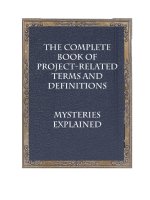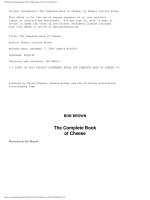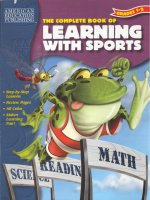THE COMPLETE BOOK OF INTELLIGENCE TESTS (philip carter)
Bạn đang xem bản rút gọn của tài liệu. Xem và tải ngay bản đầy đủ của tài liệu tại đây (1.26 MB, 214 trang )
K:/Books/1387jw/0470017732/fmatter/text_s/
The IQ Workout Series
THE COMPLETE
BOOK OF
INTELLIGENCE
TESTS
Philip Carter
K:/Books/1387jw/0470017732/fmatter/text_s/
K:/Books/1387jw/0470017732/fmatter/text_s/
The IQ Workout Series
THE COMPLETE
BOOK OF
INTELLIGENCE
TESTS
Philip Carter
K:/Books/1387jw/0470017732/fmatter/text_s/
Copyright # 2005 by Philip Carter
Published by John Wiley & Sons Ltd, The Atrium, Southern Gate, Chichester, West Sussex
PO19 8SQ, England
Telephone: (þ44) 1243 779777
Email (for orders and customer service enquiries):
Visit our Home Page on www.wileyeurope.com or www.wiley.com
Philip Carter has asserted his rights under the Copyright, Designs and Patents Act, 1988, to be
identified as the author of this work.
All Rights Reserved. No part of this publication may be reproduced, stored in a retrieval
system or transmitted in any form or by any means, electronic, mechanical, photocopying,
recording, scanning or otherwise, except under the terms of the Copyright, Designs and
Patents Act 1988 or under the terms of a licence issued by the Copyright Licensing Agency
Ltd, 90 Tottenham Court Road, London W1T 4LP, UK, without the permission in writing of
the Publisher. Requests to the Publisher should be addressed to the Permissions Department,
John Wiley & Sons Ltd, The Atrium, Southern Gate, Chichester, West Sussex PO19 8SQ,
England, or emailed to , or faxed to (þ44) 1243 770620.
This publication is designed to provide accurate and authoritative information in regard to the
subject matter covered. It is sold on the understanding that the Publisher is not engaged in
rendering professional services. If professional advice or other expert assistance is required,
the services of a competent professional should be sought.
Other Wiley Editorial Offices
John Wiley & Sons Inc., 111 River Street, Hoboken, NJ 07030, USA
Jossey-Bass, 989 Market Street, San Francisco, CA 94103-1741, USA
Wiley-VCH Verlag GmbH, Boschstrasse 12, D-69469 Weinheim, Germany
John Wiley & Sons Australia Ltd, 33 Park Road, Milton, Queensland 4064, Australia
John Wiley and Sons (Asia) Pte Ltd, 2 Clementi Loop #02^01, Jin Xing Distripark,
Singapore 129809
John Wiley & Sons Canada Ltd, 22 Worcester Road, Etobicoke, Ontario, Canada M9W 1L1
Wiley also publishes its books in a variety of electronic formats. Some content that appears in
print may not be available in electronic books.
British Library Cataloguing in Publication Data
A catalogue record for this book is available from the British Library
ISBN 0-470-01773-2 (PB) 978-0-470-01773-9
Typeset in 11=14 pt Garamond by MCS Publishing Services Ltd, Salisbury, Wiltshire.
Printed and bound in Great Britain by T.J. International Ltd, Padstow, Cornwall.
This book is printed on acid-free paper responsibly manufactured from sustainable forestry, in
which at least two trees are planted for each one used for paper production.
K:/Books/1387jw/0470017732/fmatter/text_s/
Contents
1 Introduction 1
Aspects of intelligence 3
Intelligence quotient (IQ) 7
Test 1.1 IQ test 11
2 Specific aptitude tests 25
Section I ^ Verbal aptitude 28
Test 2.1 Synonym test A 28
Test 2.2 Synonym test B 30
Test 2.3 Antonym test A 31
Test 2.4 Antonym test B 33
Test 2.5 Analogy test A 34
Test 2.6 Analogy test B 36
Test 2.7 Classification test 38
Test 2.8 Comprehension 40
Test 2.9 Advanced verbal test A ^ multi-discipline 41
Test 2.10 Advanced verbal test B ^ anagrams 46
Section II ^ Numerical aptitude 49
Test 2.11 Numerical sequence test 49
Test 2.12 Mental arithmetic 51
Test 2.13 Working with numbers 53
Test 2.14 Advanced numerical aptitude test 56
Section III ^ Technical aptitude 60
Test 2.15 Technical aptitude test 60
iii
K:/Books/1387jw/0470017732/fmatter/text_s/
3 Logical reasoning 67
Test 3.1 Pure logic 67
Test 3.2 Progressive matrices test 70
Test 3.3 Advanced logic test 79
4 Creativity 84
Test 4.0 Creativity personality test 88
Section I ^ Imagination 91
Test 4.1 Imaginative shapes 93
Test 4.2 Wild imagination 94
Test 4.3 Creative logic 95
Test 4.4 The bucket test 101
Section II ^ Lateral thinking 102
Test 4.5 Lateral thinking test 102
Test 4.6 Lateral thinking exercises 105
Section III ^ Problem solving 108
Test 4.7 Problem-solving exercises 110
5 Emotional intelligence 114
Test 5.1 Anxious or relaxed 116
Test 5.2 Extrovert or introvert 120
Test 5.3 Optimist or pessimist 127
Test 5.4 Self-confidence 131
Test 5.5 Tough or tender 138
6 Memory 144
Test 6.1 Pattern recognition A 145
Test 6.2 Word association 145
Test 6.3 Verbal dexterity and memory test ^
anagrams 146
Test 6.4 Number=shape recognition 147
Test 6.5 Pattern recognition B 147
Test 6.6 Instructions 148
Test 6.7 Pattern recognition C 148
Test 6.8 Shopping list 148
The Complete Book of Intelligence Tests
iv
K:/Books/1387jw/0470017732/fmatter/text_s/
Test 6.9 Attention to detail 149
Test 6.10 Memorising an address 149
7 Answers, explanations and assessments 150
8 Hints 205
Contents
v
K:/Books/1387jw/0470017732/fmatter/text_s/
K:/Books/1387jw/0470017732/ch01/text_s/c01.3d
1 Introduction
Intelligence may be narrowly defined as the capacity to acquire
knowledge and understanding, and use it in different novel situations.
It is this ability, or capacity, which enables the individual to deal with
real situations and profit intellectually from sensory experience.
A test of intelligence is designed to formally study, under test
conditions, the success of an individual in adapting to a specific
situation.
There are a number of different methods which purport to measure
intelligence, the most famous of which is the IQ, or intelligence
quotient test. In the formation of such tests many psychologists treat
intelligence as a general ability operating as a common factor in a wide
variety of aptitudes.
Whilst many IQ tests measure a variety of different types of ability
such as verbal, mathematical, spatial and reasoning skills, there is now
a second school of thought in which it is believed that the earlier
definitions of intelligence may be too simplistic.
It is now becoming increasingly recognised that there are many
different types of intelligence and that a high measured IQ, although
desirable, is not the only key to success in life. Other characteristics,
such as outstanding artistic, creative or practical prowess, especially
if combined with personal characteristics such as ambition, good
temperament and compassion, could result in an outstanding level of
success despite a low measured IQ. It is because of this that in recent
years CQ (creative quotient) and EQ (emotional quotient), to name
just two examples, have come to be regarded as equally important as,
or even more important than, IQ measurement.
1
K:/Books/1387jw/0470017732/ch01/text_s/c01.3d
It should also be pointed out that having a high IQ does not mean
that one has a good memory. A good memory is yet another type of
intelligence, and could result in high academic success despite a low
measured IQ test score.
The object of this book is to identify different types of intelligence
and bring together tests for different aspects of intelligence into one
book, and provide an objective assessment of abilities in a number of
different disciplines.
This will, therefore, give readers the opportunity to identify their
own strengths and weaknesses and thus enable readers to build on
their strengths and work at improving their performance in areas of
weakness.
As well as the identifying of such strengths and weaknesses, the
tests and exercises in this book perform another important function,
that of using and exercising the brain.
Despite the enormous capacity of the brain, we only use on average
2% of our potential brainpower. There is, therefore, the potential for
each of us to expand our brainpower considerably.
It is important that we continually use our brain, for example, the
more we practise at tests of verbal aptitude, the more we increase our
ability to understand the meaning of words and use them effectively;
the more we practise at mathematics, the more confident we become
when working with numbers; and the more we practise our ability to
move our fingers and manipulate small objects, the more dextrous we
become at operations involving this type of aptitude.
Our brain is undoubtedly our greatest asset, yet, for most of us, it
is the part of the body we most take for granted.
Our brain needs exercise and care in the same way as other parts
of the body. We eat the right foods to keep our heart healthy, we
moisturise our skin to keep it from drying out and, just as gymnasts
strive to increase their performance at whatever level they are
competing, by means of punishing training schedules and refinement
of technique, there are exercises, or mental gymnastics, we can do
to increase the performance of our brain and enhance quickness of
thought.
The Complete Book of Intelligence Tests
2
K:/Books/1387jw/0470017732/ch01/text_s/c01.3d
Many people still have the outdated belief that there is little they
can do to improve the brain they are born with and that brain cells
continually degenerate with age, but in fact our brain cells continually
develop new and stronger connections and adult brains can grow new
cells, irrespective of age.
We should all be aware that we have the capacity to put our brain
to even more use and unleash many hitherto untapped creative talents
by continually exploring new avenues, experiences and learning
adventures. By continually exploiting our enormous brain potential,
we all have the ability to make more and stronger connections
between our nerve cells, with the result that not only our mental but
also our physical long-term well-being will improve.
Whilst the aim of the tests and exercises is therefore two-fold,
that of identifying individual strengths and weaknesses and that of
exercising the brain, they are at the same time, and equally importantly,
designed to provide fun and entertainment to those who take them.
Aspects of intelligence
Although it is difficult to define intelligence, indeed it appears to have
no formal definition, there is, nevertheless, at least one particularly
apposite definition: the capacity to learn and understand.
Scores from standardised intelligence tests (IQ scores) are often
used to define one’s intelligence level. It is, however, becoming
increasingly accepted that they do not reveal the complete picture and
only provide a snapshot of a person’s ability in the area under
examination, so that, for example, someone who has scored highly on
a verbal test can only be said to have a high verbal IQ and someone
who has scored highly on a mathematical test can only be said to have
a high numerical IQ. Obviously, therefore, the more different types
of disciplines that are tested and examined, the more accurately the
intelligence level of the individual can be assessed.
Whilst IQ testing is broadly based on the principle of a measurable
and genetically inherited intelligence that is cast in stone for every
individual and does not increase throughout adulthood, there is
Introduction
3
K:/Books/1387jw/0470017732/ch01/text_s/c01.3d
now another school of thought which believes there are many more
different types of intelligences, some of which could be as a result of
our upbringing and development and some of which could be the
result of a natural talent with which we are born.
The concept of general intelligence,org, was devised in the early
twentieth century by the English psychologist Charles Spearman, who
established g as a measure of performance in a variety of tests.
Spearman’s research led him to the conclusion that the same people
who performed well in a variety of mental tasks tended to use a part of
the brain that he termed g.Theg factor, therefore, laid the foundation
for the concept of a single intelligence, and the belief that this single,
and measurable, intelligence enables us to perform tasks of mental
ability.
Recent studies have to a certain extent reinforced Spearman’s theory,
and research has found that the lateral prefrontal cortex istheonlyarea
of the brain where an increase in blood flow takes place when volunteers
tackle complicated puzzles.
Despite this, Spearman’s concept remains highly controversial and
is becoming increasingly challenged by those who claim that the concept
of a single overall intelligence is too simplistic.
At the same time, there is a body of research whose findings suggest
that our mental ability is not determined by biological inheritance, but
as the result of social factors such as education and upbringing.
Whilst IQ tests are, and will remain, helpful in predicting future
performance or potential in many areas, they do not provide us
with other information, such as the ability to connect with other
people emotionally or perform creative tasks that involve the use of
imagination.
Although most IQ testing only assesses what is termed ‘general
ability’ in three categories of intelligence, numerical, verbal and spatial
(abstract) reasoning, there are several other equally important and
valuable intelligences that need to be recognised and developed.
The theory of multiple intelligence (MI) advocates that the traditional
view of a single general intelligence, g, is too narrow and that humans
have multiple intelligences. By expanding our definition of intelligence
The Complete Book of Intelligence Tests
4
K:/Books/1387jw/0470017732/ch01/text_s/c01.3d
to include multiple intelligences, we can identify, appreciate and
nurture more of our strengths.
This is important, as it would be as rare for any one individual to
be endowed in all the different intelligences as it would for any one
individual not to possess some kind of talent. We all tend to be aware
of some of our abilities and limitations, for instance, some of us may
be great musicians but completely hopeless when it comes to fixing a
problem with our car; others may be championship-class chess players
but would never be able to smash a tennis ball into the opposing
player’s court; and others may possess great linguistic and mathematical
skills but feel completely at a loss trying to make small talk at social
gatherings. The fact is that no-one is talented in every domain and no-
one is completely incapable in every domain.
The originator of the theory of multiple intelligences, Howard
Gardner, a professor of education at Harvard University, defines
intelligence as the potential ability to process a certain sort of infor-
mation. The different types of intelligence are for the most part
independent of one another, and no type is more important than the
other.
In all, Gardner identifies seven different types of intelligence.
These can be summarized as follows:
1. Verbal=linguistic, e.g. lexical skills, formal speech, verbal debate,
creative writing.
2. Body=kinesthetic (movement), e.g. body language, physical gestures,
creative dance, physical exercise, drama.
3. Musical=rhythmic, e.g. music performance, singing, musical
composition, rhythmic patterns.
4. Logic=mathematic, e.g. numerical aptitude, problem solving,
deciphering codes, abstract symbols and formulae.
5. Visual=spatial, e.g. patterns and designs, painting, drawing, active
imagination, sculpture, colour schemes.
6. Interpersonal (relationships with others), e.g. person-to-person
communication, empathy practices, group projects, collaboration
skills, receiving and giving feedback.
Introduction
5
K:/Books/1387jw/0470017732/ch01/text_s/c01.3d
7. Intrapersonal (self-understanding and insight), e.g. thinking strategies,
emotional processing, knowing yourself, higher order reasoning,
focusing=concentration.
Although aspects of it are included in several of the above categories;
in addition to the above seven basic types of intelligence can be
added creativity, which has sometimes been referred to as ‘the eighth
intelligence’.
Additionally, if creativity is the eighth intelligence, then memory
must be the ninth, and both creativity and memory are explored and
tested in detail in Chapters 4 and 6, respectively.
Whilst Spearman concluded that people who performed well at
varying tasks tended to use the same part of the brain, g,Gardner
asserts that each of the above intelligences is located in one or more
particular areas of the brain. Some of the evidence for this belief is
provided by the study of people who have suffered brain damage,
either from strokes or other causes, and who may, for example, still be
able to sing words despite having lost the ability to use expressive
speech.
Although the jury may still be out on the debate as to whether the
g factor, as gauged by IQ tests, is just one single general intelligence,
or whether there are, as Gardner and others suggest, a set of
independent mental domains, it would appear to be coming increasingly
apparent that, as we learn more about the human brain and how
different parts of the brain appear to generate different intelligences,
the more compelling Gardner’s theory becomes.
The main lesson to be learned from this is that people can be
intelligent in many different ways. It is completely wrong to write off
or even put down someone who has scored badly in an IQ test which,
after all, has only provided us with one type of information about that
individual. All of us have the potential for achievement in some kind
of intelligence and we also possess the potential for improvement in
many other areas.
Although there are types of intelligence that cannot be tested in a
book, for example, aptitude at performing physical tasks or playing a
The Complete Book of Intelligence Tests
6
K:/Books/1387jw/0470017732/ch01/text_s/c01.3d
musical instrument, in the chapters that follow as many different
types of intelligence will be tested and explored as is feasible to do.
Intelligence quotient (IQ)
Intelligence quotient (IQ) is an age-related measure of intelligence
level and is described as 100 times the mental age. The word ‘quotient’
means the result of dividing one quantity by another, and a definition
of intelligence is mental ability or quickness of mind.
Such tests are based on the belief that every person possesses a single
general ability of mind. It is this which determines how efficiently each
of us deals with situations as they arise, and how we profit intellectually
from our experiences. This ability of mind varies in amount from person
to person, and is what intelligence (IQ tests) attempt to measure.
Generally such tests consist of a graded series of tasks, each of
which has been standardised with a large representative population of
individuals. Such a procedure establishes the average IQ as 100.
IQ tests are part of what is generally referred to as ‘psychometric
testing’. Such test content may be addressed to almost any aspect of
our intellectual or emotional make-up, including personality, attitude
and intelligence.
Psychometric tests are basically tools used for measuring the mind;
the word ‘metric’ means measure and the word ‘psycho’ means mind.
There are two types of psychometric test, which are usually used in
tandem. These are aptitude tests, which assess your abilities, and personality
questionnaires, which assess your character and personality.
In contrast to specific proficiencies, intelligence tests are standard
examinations devised to measure human intelligence as distinct from
attainments. There are several different types of intelligence test, for
example, Cattell, Stanford^Binet and Wechsler, each having its own
different scale of intelligence.
The Stanford^Binet is heavily weighted with questions involving
verbal abilities and is widely used in the United States of America, and
the Weschler scales consist of two separate verbal and performance
sub-scales, each with its own IQ rating.
Introduction
7
K:/Books/1387jw/0470017732/ch01/text_s/c01.3d
It is generally agreed by advocates of IQ testing that an
individual’s IQ rating is mainly hereditary and remains constant in
development to about the age of 13, after which it is shown to slow
down, and beyond the age of 18 little or no improvement is found. It
is further agreed that the most marked increase in a person’s IQ takes
place in early childhood, and theories are continually put forward
about different contributory factors, for example, it has been claimed
recently, following research in Japan, that the playing of computer
games by children, which involve a high degree of skill and agility of
mind, have resulted in higher IQ measurement.
IQ Tests are standardised after being given to many thousands of
people and an average IQ (100) established, a score above or below
this norm being used to establish the subject’s actual IQ rating.
IQ score
% of population
0 100
170
25
Because beyond the age of 18 little or no improvement in a person’s
IQ rating is found, the method of calculating the IQ of a child is
different to the method used for an adult.
When measuring the IQ of a child, the subject will attempt an IQ
test which has been standardized with an average score recorded for
each age group. Thus, a child aged 10 years who scored the results
expected of a child of 12 would have an IQ of 120, calculated as
follows:
mental age (12)
chronological age (10)
 100 ¼ 120 IQ
However, adults have to be judged on an IQ test whose average
score is 100 and their results graded above and below this norm
according to known scores. A properly validated test would have to
The Complete Book of Intelligence Tests
8
K:/Books/1387jw/0470017732/ch01/text_s/c01.3d
be given to some 20,000 people and the results correlated before it
would reveal an accurate measurement of a person’s IQ.
Like most distributions found in nature, the distribution of IQ
takes the form of a fairly regular bell-curve (see diagram above). On
the Stanford^Binet scale, half the population fall between 90 and 110
IQ, half of them above 100 and half of them below; 25% score above
110; 11% above 120; 3% above 130 and 0.6% above 140. At the other
end of the scale the same kind of proportion occurs.
The earliest known attempts to rank people in terms of intelligence
date back to the Chinese Mandarin system, circa 500
B
.
C
., when studying
the works of Confucius enabled successful candidates to enter the public
service. The top 1% of candidates were successful in progressing to the
next stage, where they would again be run off against each other, and
the procedure repeated yet again through a final layer of selection.
Thus, the chosen candidates were in the top 1% of the top 1% of the
top 1%.
The first attempt to measure scientifically the difference between
the mental abilities of individuals was made by Sir Francis Galton in
the nineteenth century, when he tried to show that the human mind
could be systematically mapped into different dimensions.
The first modern intelligence test was devised in 1905 by the
French psychologists Alfred Binet and Theodore Simon after they
were commissioned by the French government to construct tests that
would ensure no child be denied admittance to the Paris school system
without formal examination. The pair developed a 30-item test, which
included a wide range of different types of problems.
In 1916, the American psychologist Lewis Terman revised the
Binet^Simon scale to provide comparison standards for Americans
from age 3 to adulthood and the concept of the ratio of the mental age
to chronological age, multiplied by 100, was added. Terman devised the
term ‘intelligence quotient’ and developed the Stanford ^Binet intelligence
test to measure IQ after joining the faculty of Stanford University as
professor of education. The Stanford^Binet test was further revised in
1937 and 1960 and remains today one of the most widely used of all
intelligence tests.
Introduction
9
K:/Books/1387jw/0470017732/ch01/text_s/c01.3d
In the mid-nineteenth century psychologists used information-
loaded tests to assess the intelligence of their clients. Later, psychologists
introduced the concept of mental speed when assessing performance.
Around 1930, Furneaux demonstrated that a relationship did exist
between power, meaning the absolute difficulty of a problem, and
speed, meaning the time a person required to solve it. By increasing
the difficulty by 30%, you double the time required to solve it, but a
60% increase will lengthen the time five-fold.
The first IQ testing on a mass scale was carried out by the US
army during the First World War. Personality tests or character tests
soon followed, but in the 1920s and 1930s studies began to define
more closely the general concept of intelligence. What emerged was
recognition of fluid and crystallised intelligence. Fluid intelligence was
measured by references to spatial items, such as diagrams, drawings or
pegs, and crystallised intelligence was measured through language and
number.
There are many different types of intelligence tests; however, a
typical IQ test might consist of three sections, each testing a different
ability, usually comprising verbal reasoning, numerical ability and
diagrammatic, or spatial, reasoning. In order to assess your overall
general ability, the questions in the test that follows are multi-discipline
and include a mix of verbal, numerical and diagrammatic questions,
as well as additional questions involving logical thought processes
together with a degree of lateral thinking.
While it is accepted that IQ is hereditary and remains constant
throughout life and, therefore, it is not possible to improve your
actual IQ, one weakness of this type of testing is that it is possible
to improve your performance on IQ tests by practising the many
different types of question, and learning to recognise the recurring
themes.
In subsequent chapters of this book, readers will have ample
opportunity to test themselves in different areas of brain activity and
to identify their strengths and weakness in specific areas of intelligence.
It must be emphasised that a person who is good at IQ tests is not
necessarily capable of excelling at academic tests, regardless of how
The Complete Book of Intelligence Tests
10
K:/Books/1387jw/0470017732/ch01/text_s/c01.3d
logical and quick-witted he=she is. Often motivation and dedication
are more important than a high measured IQ rating. To score highly
on an academic test requires the ability to concentrate on a single
subject, obtain an understanding of it, and revise solidly in order to
memorise facts prior to an examination. Often it is difficult for
someone with a high IQ to do this because of an overactive and
enquiring mind, which cannot direct itself on one subject for very
long and forever wishes to diversify. Such a person would have to
apply a high level of self-discipline in order to succeed at academic
tests but, if able to apply this self-discipline, would be likely to obtain
ahighpassmark.
Because the test that follows has been newly compiled for this
book, it has not been standardised, so an actual IQ assessment cannot
be given. Nevertheless, a guide to assessing your performance is
provided in the Answers section.
A time limit of 90 minutes is allowed for completing all 40
questions. The correct answers are given at the end of the test, and
you should award yourself one point for each completely correct
answer. You should not exceed the time limit, otherwise your score
will be invalidated.
Where preferred, the use of a calculator is permitted on numerical
questions, except where indicated.
Test 1.1 IQ test
1 The white dot moves two places anti-clockwise at each stage and
the black dot moves one place clockwise at each stage. After how
many stages will they be together in the same corner?
Introduction
11
K:/Books/1387jw/0470017732/ch01/text_s/c01.3d
2 72496 is to 1315
and 62134 is to 97
and 85316 is to 167
therefore 28439 is to ?
3 Put the following words into alphabetical order:
arthropod, artificer, arteriole, artichoke, arthritis, articular,
artillery, arthritic
4 Which two words are most opposite in meaning?
imaginary, realistic, illegible, impracticable, radical, embellished
5 What numbers should replace the question marks?
2
6
3
5
6
3
6
2
3
6
3
6
7
3
6
3
?
?
?
?
6 Which group of letters is the odd one out?
CEFH LNOQ UWXZ
HJKN PRSU DFGI
7 Identify two words (one from each set of brackets) that form a
connection (analogy) when paired with the words in capitals.
RESTRAIN (suppress, deny, conceal)
WITHHOLD (curb, reserve, conceal)
The Complete Book of Intelligence Tests
12
K:/Books/1387jw/0470017732/ch01/text_s/c01.3d
8
?
Which figure should replace the question mark?
ABCD
9 Spell out a 12-letter word by moving from letter to adjacent
letter, horizontally and vertically (but not diagonally). You must
find the starting point and provide the missing letters.
C
N
C
L
E
A
O
I
D
E
10 What numbers should replace the question marks?
100, 95, ?, 79, 68, ?, 40, 23
11 Associate is to colleague as accomplice is to:
consort, friend, accessory, comrade, follower
12 Which is the odd one out?
famous, illustrious, acclaimed, fabulous, noteworthy
13 What number should replace the question mark?
9
7
3
2
64
5
2
1
619
13
?
5
11
Introduction
13
K:/Books/1387jw/0470017732/ch01/text_s/c01.3d
14 Which is the odd one out?
ABC
ED
15 GAINED VOTE is an anagram of which two words that are
similar in meaning?
16 What number should replace the question mark?
49 62615
85 29177
53 74?
The Complete Book of Intelligence Tests
14
K:/Books/1387jw/0470017732/ch01/text_s/c01.3d
17 Which word in brackets is most opposite in meaning to the word
in capitals?
MITIGATE (augment, palliate, appreciate, trust, destroy)
18
Which shape below is identical to the shape above?
AB
CDE
19 Which two words are closest in meaning?
educated, clear, literal, enervated, wordy, verbatim
Introduction
15
K:/Books/1387jw/0470017732/ch01/text_s/c01.3d
20 What number should replace the question mark?
19 917
23
12 25
13
?31
21 is to as
is to
ACB
DFE
The Complete Book of Intelligence Tests
16









